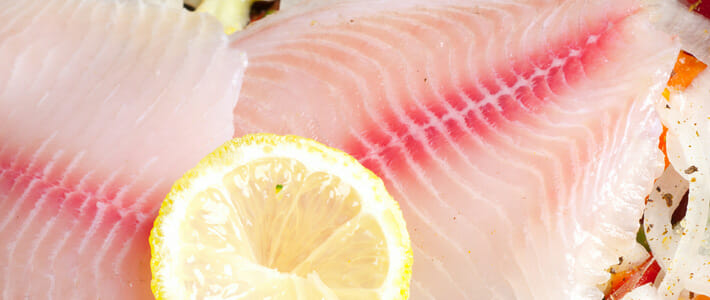Tilapa
Oreochromis spp

Tilapia is the common name for nearly a hundred species of cichlid fish from the tilapiine cichlid tribe. Tilapia inhabit a variety of fresh water habitats including shallow streams, ponds, rivers and lakes. Historically they have been of major importance in artisan fishing in Africa and the Levant and are of increasing importance in aquaculture. Tilapia can become problematic invasive species in new warm-water habitats, whether deliberately or accidentally introduced, but generally not in temperate climates due to their inability to survive in cool waters, generally below 60 °F. The skin color of a tilapia ranges from black to gold to red.
Tilapia is raised in salt or freshwater and is known for its easy adaptability and fast growth, reaching about 2 pounds within the first 8 months after hatching.
Product pdf for download-
3.5 oz (100g) raw edible portion
-
Calories 98
-
Calories from fat 22
-
Total Fat 2.4g
-
Saturated Fat 0g
-
Cholesterol 0mg
-
Sodium 52mg
-
Carbohydrates 0g
-
Protein 18.5g
-
Potassium 0mg
Interesting Fact
Tilapia are “Mouth Brooders,” meaning that after their eggs are laid and fertilized, they carry them in their mouths for two weeks until the eggs hatch.
Alternatives
Cod, catfish, and Lake Victoria can be used as substitutes for this species.
Source
In the U.S., tilapia is cultured in fresh water, primarily in the southern and western states. Some wild product is also available from Florida. Other sources include Central and South America, Indonesia, Thailand, Taiwan, India, and the Philippines, where tilapia is raised in both fresh and brackish water.
Harvest Method
Tilapia is farmed in ponds and tanks and hook and line or hand-netted in the wild.
Harvest Season
Harvested year round.
Flavor/ Texture
Tilapia has a mild, sweet flavor similar to sole. The texture of tilapia is lean with tender flakes.
Preparation
Tilapia can be baked, broiled, sautéed, steamed, or poached. Increasingly, tilapia is also being served raw and as sushi.
Quality Control
Tilapia has a long shelf life when fresh as a result of tightly regulated harvesting, processing, and shipping processes. Water quality and high-grade feed are the keys to raising premium tilapia. Tilapia act like sponges, taking on the flavor of the environment in which they are harvested. As such, tilapia raised in cement tanks are generally better tasting than those raised in ponds, which may take on a muddy or gritty flavor.
Market Segments
Tilapia is appropriate in the casual dining, fine dining, hotel, and resort/club segments of the market.